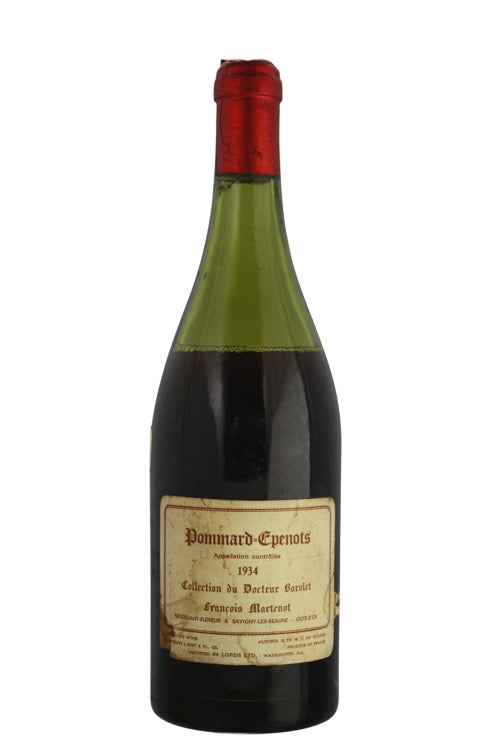1
/
of
1
- Home
- Old & Rare: Burgundy
- Martenot Pommard-Epenots Collection du Docteur Barolet (Low Fill) - 1934 (750ml)
Martenot Pommard-Epenots Collection du Docteur Barolet (Low Fill) - 1934 (750ml)
Martenot Pommard-Epenots Collection du Docteur Barolet (Low Fill) - 1934 (750ml)
Regular price
$599.99
Sale price
$599.99
Regular price
$1,873.75
Unit price
/
per
Availability:
2 In Stock
$25 Shipping on Orders +$299
Couldn't load pickup availability
Share :

- varietal
- Region
- Sub - Region
- Type
- Reviews
Pinot Noir is responsible for some of the world’s finest wines. Famed for producing the red wines of Burgundy and the Côte d’Or in particular, it is now widely grown in cool climates across Califonia and Oregon, and with increasing success in New Zealand. Although typically used to produce varietal wines, Pinot Noir makes a significant contribution in the wines of Champagne, where it is vinified as a white wine and blended with Cardonnay and Pinot Meunier. On the whole, fresh summer fruit of strawberries, raspberries and red cherries tend to be the identifying qualities, however richer versions express darker fruit including black cherries (kirsch), cherry cola, leather and violets to name a few.
Two hundred miles south east of Paris lies the famous and historic wine region, known in French as Bourgogne. The Cote d'Or, the heartland of the region, consists of two distinct sub-regions split on either side of the town of Beaune.The Côte de Nuits to the north, includes the famous villages of Vosne-Romanee, Gevrey-Chambertin, and Nuits-Saint-Georges and are known primarily for making red wine from Pinot Noir.Although The Côte de Beaune to the south still makes some magnificent reds (see Volnay and Pommard), white wine made from Chardonnay is the main focus. The most famous villages are Puligny-Montrachet and Meursault. Burgundy has three other important regions. The village of Chablis (exclusively Chardonnay) encompassing the region's most northerly vineyards. The Côte Chalonnaise and Mâconnais to south are quantitatively speaking more important. Agriculture is more diverse with a significant portion of the land devoted to livestock and arable farming.
Sandwiched between Beaune and Volnay, Pommard produces, along with the grand cru Le Corton, some of the finest and most powerful reds in the Cote de Beaune district of Burgundy. Although present in neighboring communes, the higher concentration of active limestone here helps produce more substantial and age-worthy wines. The river Dheune running east to west splits the commune into two. The finest of the 28 premier crus lie on either side of the river with Les Épenots to the north and Les Rugiens to the south. The former, while still showing great concentration is more mellow and supple while the latter is more intense and tightly woven. Several critics have suggested that, were the classification system more fluid, these vineyards would surely be contenders for elevation to Grand Cru. Les Jarolieres and Les Fremieres are closer in style to bordering Volnay and offer good value. Those vineyards closer to the center, near the Dheune, such as Les Poutures and Le Clos Blanc, are often overlooked by label hunters, but consistently produce good examples of Pommard.
Red wine is wine made from dark-coloured grape varieties. The color of red differs based on the grapes variety or varieties used.Interestingly, black grapes yield a juice that is greenish-white. The actual red color comes from anthocyan pigments (also called anthocyanins) from the skin of the grape (exceptions are the relatively uncommon teinturier varieties, which produce a red colored juice). Most of the production centers around the extraction of color and flavor from the grape skin.


